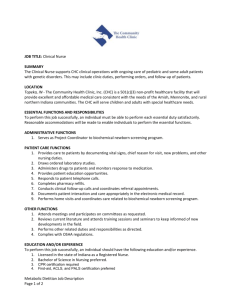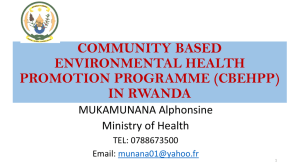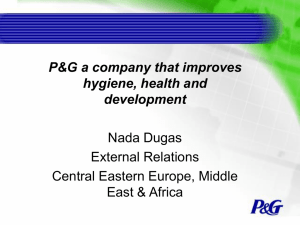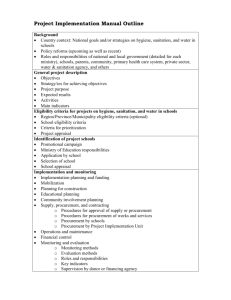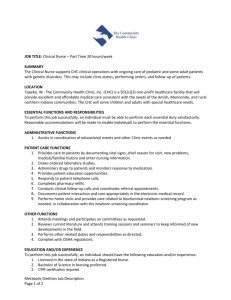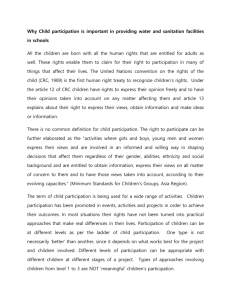Health promotion -CBEHPP presentation
advertisement
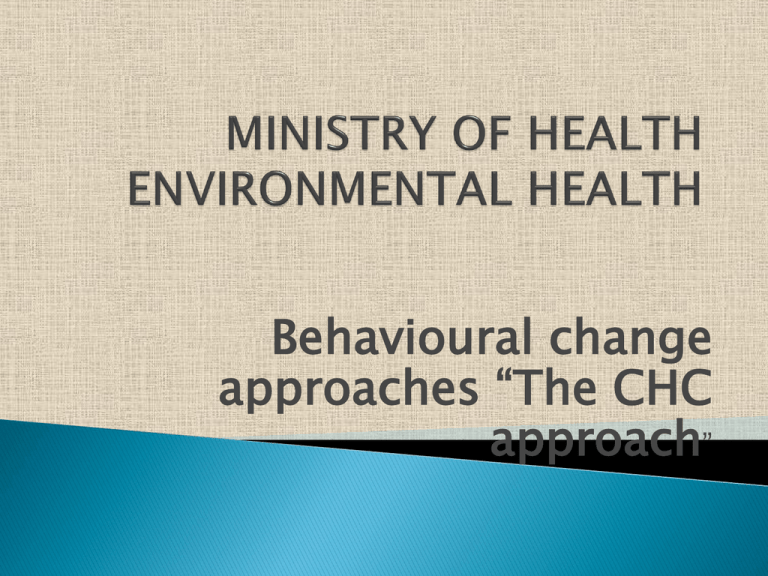
Behavioural change approaches “The CHC approach” COMMUNITY-BASED COMMUNITY-BASED ENVIRONMENTAL ENVIRONMENTALHEALTH HEALTH PROMOTION (CBEHPP) PROMOTION PROGRAMME PROGRAMME (CBEHPP) • • • MoH Environmental Health Enhancing human & natural resources MINEDUC MINAGRI National development and CBEHPP (CHCs) MINALOC Increasing access to rural & urban WSS MININFRA poverty alleviation MINECOFIN Water & Sanitation Programme of World Bank UNICEF WaterAid & KHI Applied Health Education and Development (AHEAD) for private technical support Lux development World Vision Rulindo Ngoma Muhanga Bugesera Nyabihu Rubavu Burera Musanze Rwamagana Gatsibo Defining CBEHPP Roadmap Mapping CBEHPP with development partners Developing guidelines for establishing CHC Developing of CBEHPP tools Training of CBEHPP National core team Orientation meeting in ten Districts ToT training in nine District (220 participants) 2000 sets of CHC dialogue tools, 2000 CHWs training manuals, 400 EHO training manuals and 20,000 membership cards printed Training of Community Health Workers in Nyabihu (1419), Burera (272) and Bugesera (82), total of 1773 Establishment of community hygiene clubs to 79% Approval of CBEHPP tools by MOH that top ten leading causes of morbidity and mortality are caused by infectious diseases • that over 90% of consultations at the rural health facilities are preventable • that they include malaria, diarrhoea, skin diseases, typhus, cholera, intestinal parasites, acute respiratory infections (ARIs), HIV/AIDS, STIs, tuberculosis, meningitis and • that 66% of school children are infected with worms • that and 44% of pupils suffer from amoebiasis. • That these are related to inadequate facilities for waste management and unhygienic practices. • Ibikorwa , imyifatire ku isuku n’isukura n’ingaruka z’umwanda 1. Ingo zivoma amazi ku masoko atunganijwe (CFSVA) 2. Ingo zinywa amazi meza (IDHS) 3. Ingo zidafite imisarane muri rusange (IDHS) 4. Ingo zifite imisarane ivuguruye (CFSVA) 5. Ababyeyi bakaraba intoki n’amazi n’isabune bavuye ku musarane (CFSVA) Umwak Ijanish a a (%) 2009 81% 2009 2009 41% 03% 2009 56% 2009 58% Percentage of children under five years who had symptoms of ARI, fever, or diarrhea in the two weeks preceding the survey (PDHS 2010 Diarrhoea in children between 12 – 23 months were reported to 25% whereas 6 – 11 months were 22% Anemia in children 6-59months ◦ Moderate 14% ◦ Mild anemia 24% ◦ Any anemia 38% Malnutrition ◦ Stunted (height for age) 44% ◦ Wasted (weight for height) 3% ◦ Under weight (weight for age) 11% Mortality ◦ Infant mortality 50/1,000 live birth ◦ Under fives 76/1,000 live birth ◦ Maternal mortality 487/100,000 live birth Access to improved water source: 74% Drinking treated water 49% Households using improved toilets 55% Households with places for handwashing 10% Handwashing with soap 21% The MDG Challenge : 11 million people in RWANDA ?% unhygienic latrines 44% = 5 million x 40kgs faeces per annum = 200 million tons per annum Have the ‘Great Unserved’ agreed to change? What is different? We have failed to get behaviour change from communities. Why ? Social Planning People only change when they are forced to do so by authority. 1970’s 1980’s Health Belief Model People will improve their hygiene if they know the reason 1990’s The Participatory Approach People will change if they participate PRA: Participatory Rural Appraisal PHAST : Participatory Hygiene and Sanitation Transformation 2000’s Social Marketing People are more interested in being smart than healthy APPEAL TO STATUS : SUBLIMINAL METHOD • National health days • Radio and TV programs • Flyers and pamphlets • Advertising on posters • Celebrity advertising • Community drama Source: Curtis et al. (2001) Photo: Matthews B. 2005. Malawi Sanitation Programme 2000’s Community Led Total Sanitation (CLTS) People will change their behaviour out of self respect Psycho-Social Perspective: Public Name and Shame Source: Kar, K & Pasteur, K. (2005) Subsidy or Self-Respect? Community Led Total Sanitation. An Update on Recent Developments. IDS Working Papers - 257. 2000’sCommunity Hygiene Club Approach People change through peer pressure / Group Consensus I fear the jealousy of others if I change. Pull her down (PhD) Syndrome I am not sure if the decision is correct I don’t like being different from others I prefer to wait and see if changes bring reward 1995: COMMUNITY HYGIENE CLUB (CHC) Approach Clubs have 50- 100 members ; They meet weekly in one hour for at least 6 months Learn and discuss together using participatory activities (PHAST) Source: Waterkeyn, J and Cairncross, S. (2005) See|: www.africaahead.com How is the CHC Approach Different? Reinforcement: Peer pressure / home visits Homework: Recommended Practices Measurable: Specific Targets Each Week Concept of community participatory programming Community diagnosis Monitoring & Evaluation Participatory planning Implementation of activities Community Hygiene Club Methodology Applied Head Education and Development (AHEAD) A Process of Development using Community Hygiene Clubs as a Vehicle for Change Hygiene Promotion Sanitation Home based Care / HIV Water Community Health Hygiene Club Education 2003 Sierra Leone 0% - 98% ZOD in one year Post conflict villages being reconstructed % CHC Members 43% Latrines built Cat sanitation 57% Demand Led Sanitation in Zimbabwe : 1998/99 8,000 latrines constructed in 1998 in 57 Districts 2,400 latrines constructed in 1999 in 2 Districts Project 23% Project Nation 77% Nation Roles and Responsibilities of CHC Executive Committee What are the positions required for the executive committee members? Brainstorm the roles and responsibilities for the different positions of the executive committee members. How would you facilitate selection of the executive committee members? DISCUSSION : the ideal attributes of each officer to ensure that the correct people are elected. An Executive Committee is made up of at least six people (6-8) who will guide the CHC: Chairperson: It is preferable to have a woman as a chairperson if the majority of people in the CHC are women. She should be someone who is highly respected in the community, and has a strong personality to lead others and make decisions without being afraid. She also needs to be an inspiration and a good example, leading the kind of life that is appropriate for the head of a health club. Vice Chairperson: This can be a man or a women, who can take over if the Chairperson is sick or absent. They should have the same good character as the Chairperson Secretary: It is most important that this person is literate and well schooled, as well as neat and methodical, with good handwriting and careful character. She or he has to keep all the records of the health club, especially the register, household inventory and minutes of meetings. Vice Secretary: This person should stand in for the secretary if she or he is absent, and also assist in the above duties so that all the information is not in the hands of one person. Treasurer: This person is only needed if money is collected within the club or if there are donations that need to be recorded. Obviously he/she must be a very honest person who has never had any complaints against him/her. She must also be in a position to keep money in a safe place or be able to travel to town to bank the money. Of course she/he must have a good education and be very numerate. Vice Treasurer: She/ he must assist the treasurer and make sure that all the money is kept in a transparent way. If there are any doubts she or he must alert the Chairperson. Facilitator: If the facilitator for the health sessions is CHW, she/he should also be on the executive committee to help and guide all activities as she/he is the most qualified in this respect. Once the duties of facilitation are over, she/he should become the Water and Sanitation and Hygiene Officer, who will continue to be responsible for monitoring the public health issues in the areas, and alerting the authorities or CHC if there is any need for action. WHO SHOULD NOT BE ON THE COMMITTEE As CHCs should always make sure that they are not affiliated with any particular political party or a particular religion. No politician, councilor, traditional or religious leader should be given a position on the Executive Committee because this may lead to others refusing to join, or to the CHC being used for purposes other than the improvement of health. METHOD: VOTING Ask the group to nominate people for each of the jobs that need to be done. Give each person a small piece of paper and let each write the name of one of those who have been nominated. Let them vote in private and count who has won. Announce who has been elected and congratulate the winners. Explain that they will be officers for one year after which there must be new elections at an Annual General Meeting. Plan when and where the next meeting will be. Arrange to meet the committee on their own to discuss the way forward. A membership card is the key to the programme, standardised content of training 1 Introduction Health Slogan 2 3 4 5 6 7 8 9 10 11 12 13 14 15 16 17 18 19 20 Registration Mapping Scabies Ringworm Roundworm Threadworm Diarrhoea Food Practices Food Story Safe Water Chain Saving Water Refuse Disposal Sanitation sorting Sanitation ladder Sanitation story Sanitation planning HIV/AIDS story HIV/AIDS prevention Graduation Health Song Clean clothes/bedclothes Scabies treatment Worm treatment Clean children/fingernails/hair Clean pets/well controlled Food safe/covered food/shelves Squeeze bottle/soap No dirty plates/pots Covered drinking water Jug/ladle for drinking water Good refuse disposal/swept yard No faeces nearby home Clean latrine & roster Well maintained latrine Cover on latrine/bucket Oral Rehydration Solution ABC - use of condom Home pride/flowers/tree No Material Handouts: The Only Reward is a Certificate Planning Community Based Environmental Health Promotion Programme 10. PLANNING: SETTING REALISTIC TARGETS It is important to know when you start the programme exactly what you are trying to achieve in terms of targets. 1. How many Health Clubs do you expect to be able to achieve in one year? The number of CHCs that you can do in an area depends entirely on the amount of time the Village Health Worker can give to the programme. At a minimum she should be able to run one health club, meeting once a week for two hours. However if she can meet one health club every day and can manage 5 per week, then the program becomes much more cost-effective. As the training takes six months, she may be able to do 10 CHCs in one year. This is the extreme and few manage to coordinate this many CHCs at once. 2. How many members do you expect per health club? In most countries CHC members number between 50 and 100 members. The amount depends on the density of the population, the season when the training takes place, and the charisma and competence of the facilitator. Even if the clubs are small (less than 30 members) it is worth persevering as they often expand later once people have seen what they are about. When a club becomes bigger than 100 it may be worth splitting it into 2 clubs to enable easier communication at the sessions. 3. What percentage of households in the area should be represented in the health club? You should aim for all households to have a representative in the CHC. However, this is seldom possible practically so aim for at least 50% the first year and 80% in the second year. 4. How many months will the health promotion training continue? The training is designed to last for 20 sessions of about two hours each, to be held every week for six months. However it usually takes about a month to mobilize the community to join, as well as to conduct a base line survey (household inventory). In addition sometimes sessions are delayed because of rain, holidays, funerals and other reasonable priorities, so usually it takes 8 months to complete the 24 sessions. Sometimes the community asks for repeats to enable them all to catch up on missed sessions so they can get their certificate. So to be able to be unstressed it is usually wise to plan one intake of members each year rather than try and squeeze in two intakes in a year. 5. How many of the sessions do you expect each member to complete? Of course we would want every member to complete all 20 sessions, but this is setting a very exacting standard which will not be realistic. Past experience has shown that 50-60% of all members are able to complete all the sessions. 6. What do you expect in terms of the average attendance at each meeting? Attendance means the number of people at each session compared to the total membership. Adding the attendance of each session and taking an average of all sessions, is a simple way to monitor the relative success of each CHW, and will also enable managers to see which facilitators are the most cost effective, by dividing their costs by the average attendance. Past experience has shown average attendance is between 30 - 50% of the membership. In CHCs where attendance is compulsory, average attendance can be 80-100%. 7. What do you expect in terms of % members following all recommended practices? We can measure how much change is taking place in the Community Hygiene Club, by monitoring the hygiene practices of the members. We see what the situation is at the beginning and then compare to after the training. The difference between the two is the percentage (%) of change. To monitor change is to best to monitor all the members, but if this is not possible due to time constraints then at least 30% of the households should be surveyed. CHC projects in the past have achieved between 20% to 47% change (Waterkeyn & Cairncross, 2005). DISCUSSION: •Think of some of the issues that may be a problem and how this could be worked into the planning • •SETTING TARGETS: Discuss the targets that are appropriate for your area. • How many functional Hygiene Clubs do you expect to be able to achieve in one year? How many members do you expect per hygiene club? What percentage of households in the area should be represented in the hygiene club? How many months will the health promotion training continue? How many of the sessions do you expect each member to complete. What do you expect in terms of the average attendance at each meeting? •Remember: •The training in CHC usually results in a strong demand for sanitation, so management must have a strategy to offer in terms of assistance for sanitation. The CBEHPP does not offer financial assistance / subsidy for the construction of latrines. The group has to make their own plans as to how this can be done at a basic level •What will you do if there is a demand for latrines to be built? •What will you do if there is a demand for safe water infrastructure to be built? •Train a latrine builder in each CHC so there is local skill available for hire by CHC members themselves Link the CHC up with the local Women’s Union which could assist in starting a revolving fund for latrine construction • Link the CHC up with the local promoters for the Rwanda Bank of Social Policy water and sanitation loans • •Provide • latrine subsidies only to the poorest of the poor Develop a training plan for the CHWs in your districts? Note • Role of the CHWs in CHC start up • Content based on their responsibilities • Training plan of not more than one day • Develop the necessary budget • Strategies to mobilization required resources • But may include: • What are the objectives • What are the key activities • What is the schedule and when • Who is responsible for what • What are the indicators/targets • How will the results be verified • What will it cost
